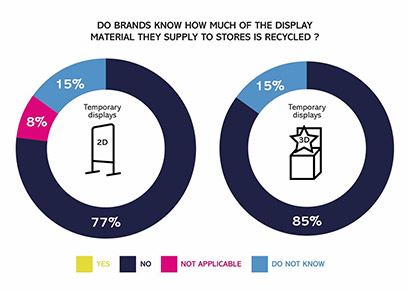Key findings of the POPAI study
With recycling high up on corporate agendas, POPAI has investigated to find out whether temporary POSM & Packaging benefit from such consideration at their end-of-life stage. Let’s say there is work to be done…
With recycling high up on corporate agendas, POPAI has investigated to find out whether temporary POSM & Packaging benefit from such consideration at their end-of-life stage. Let’s say there is work to be done…
Key finding to increase POSM & packaging recycling
In 2021, Antalis teamed up with POPAI UK to sponsor their research on recycling practices of POS material.
Why? Because, at Antalis, we are committed to more responsible Visual Communication market. So, we believe supporting this kind of initiative is vital to drive positive change and inspire better practices in our industry.
So, through a comprehensive methodology combining desk research, senior brand and retailer interviews and back of store investigation, POPAI takes a closer look at what happens to temporary point-of-sale materials (POSM) and secondary packaging (mainly disposed of in the UK and Ireland through retailers’ waste streams). The study also seeks to identify any barriers that deter or prevent efficient recycling of POSM and secondary packaging.
Work to be done, strides being made.
The POPAI Temporary POSM & Packaging Recycling Report reveals that with recycling in retail a hot topic for many years now, the focus has fallen mainly on primary packaging (in direct contact with the product). This packaging, which leaves the store, is for the shopper to dispose of. And he generally does it.
However, little attention appears to be paid to the recycling of point-of-sale displays. Why? POPAI finds out that the recycling and environmental credentials of POSM rarely feature in retailers and brands CSR policies. More than that, an overwhelming majority of brands have no idea how much of the POSM display they supply to stores is ultimately recycled. The general assumption is that cardboard systematically goes into retailers’ cardboard recycling streams. However, it not always the case.

Who should be responsible for the recycling of POSM and secondary packaging?
The industry is unanimous in the belief that responsibility should lie with retailers. Nonetheless, some brands acknowledge their role in promoting recycling at end of life. Encouragingly, it appears that dialogue between retailers, brands, and suppliers is getting stronger. It is simply vital since collaboration is a crucial accelerator to improve recyclability and identify ways to improve recycling rates.
Identified key recycling accelerators
- Recycling and disassembly instructions
- Stronger eco-design guidelines
- Consistency of approach
The research highlights that highly encouraging initiatives are being implemented to recycle better and to measure progress. However, it also stresses how challenging it will remain to source reliable data exploitable to make fair and reliable comparisons across the industry. That is why stronger legislation and public supervision is also identified as a significant lever for positive change.

The future can be bright
Despite lack of time, experience, resources and intelligence, intentions are good. Sustainability and recycling are high on the agenda for most retailers, brands and suppliers. One thing is clear. There is much work ahead to make real inroads in this area. And Antalis is committed to inspiring better recycling practices among its community.







